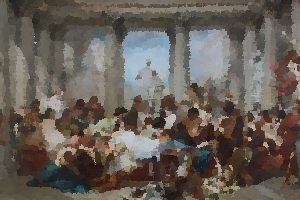In Paris, France, Musee d'Orsay is a museum located in what used to be a railway station, the Gare d'Orsay. This museum boasts a huge collection of paintings by Renoir, Monet, Delacroix, Degas, Gaugin, Van Gogh, and other impressionist artists. It also focuses on the art scene between 1848 and 1915, which is the early modern era for art in France. The collection also includes not just paintings but furniture, photographs, and sculptures.
The setting itself is an interesting tidbit that adds to the fascination of Musee d'Orsay. The railway station dates back to the 1900s when it was built for the 1900 Exposition Universelle. This was the creation of three architects, namely Victor Laloux, Emile Benard, and Lucien Magne. The Gare d'Orsay was where the railways entered from the southwest of France terminated until the late 1930s. As longer trains were being built, the terminal became less and less suitable because it only had short platforms that could not accommodate the trains. It was eventually closed as a railway station in 1973.
 A beautiful view of the Orsay Museum by the Seine river in Paris. [Report image]
A beautiful view of the Orsay Museum by the Seine river in Paris. [Report image]The station, which lies along the peaceful Seine River, was subsequently converted into a museum, and it was renovated accordingly. The architects Pierre Colboc, Renaud Bardon, and Jean-Paul Philippon designed the museum, which had four floors covering some 20,000 square meters. It opened to the public on December 1, 1986, with the presence of President Francois Mitterrand.
At the Musee d'Orsay, one is afforded a view of how modern art (painting, design, photography, and sculpture) evolved. One can look at the collection, which is quite intriguing and appealing and ranges from the art nouveau design and those inspired by expressionism, neoclassicism, and expressionism. Examples of cherished works include Olympia and the Luncheon on the Grass by Manet, The Parade and L'Absinthe by Degas, Blue Water Lilies, and Series of The Poplars by Monet and Apples and Oranges by Cezanne.
 Some sculptures inside the Musée d'Orsay. [CC] credit.
Some sculptures inside the Musée d'Orsay. [CC] credit.Here are the highlights of your tour of the Museum:
On the Ground Floor, you will see artworks dating back to 1848 up to the early 1870s. You will see works from the pre-symbolist and Academic schools concentrated on the galleries on the right side. This includes masterpieces by Degas (his early artworks), Delacroix, Moreau, and many others. The left side, meanwhile, is dedicated to the works by pre-impressionists, Naturalists, and realists. These are where you can view major works by Millet, Manet, Courbet, and Corot. Some sculptures and other decorative objects belong to the eclecticism movement in the mid-19th century.
Going up to the middle level, you will mainly find late 19th century works – paintings, decorative objects, and pastels. These mostly feature Art Nouveau works, as well as Naturalist and Symbolist works. There are also masterpieces by Denis, Bonnard, Roussel, as well as foreign artists such as Munch and Klimt.
 Les romains de la decadence painting by Thomas Couture in the Musée d'Orsay. [CC] credit.
Les romains de la decadence painting by Thomas Couture in the Musée d'Orsay. [CC] credit.Meanwhile, the Upper Level (2) is for neoimpressionist works, featuring Gaugin, Toulouse-Lautrec, Seurat, Signac, and the Pont-Aven and Nabist painters.
 The self-portrait of Vincent Van Gogh. [CC] credit.
The self-portrait of Vincent Van Gogh. [CC] credit. The top floor is undoubtedly the crowning point of the collection. This is where you can find major examples of expressionism and impressionism, mainly works by Sisley, Monet, Degas, Renoir, Pissarro, and Caillebotte. This is also where you can find the highly-acclaimed Gachet collection, where Cezanne and Van Gogh's works are featured. The Terrace is dedicated to sculptures in the 19th century, with creations by the renowned Rodin.